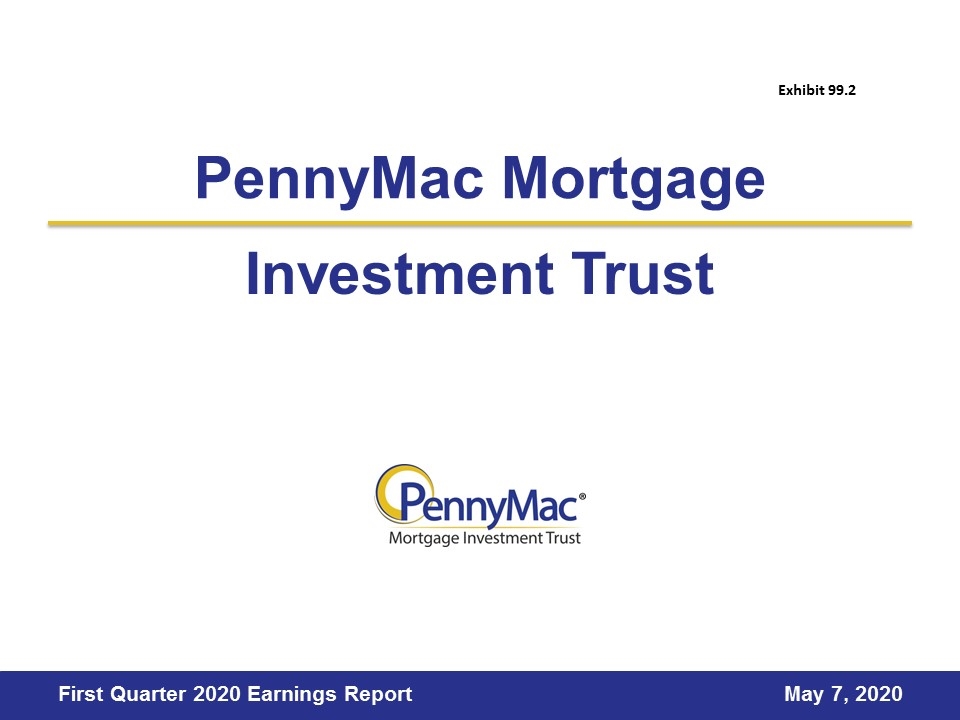
PennyMac Mortgage Investment Trust May 7, 2020 First Quarter 2020 Earnings Report Exhibit 99.2
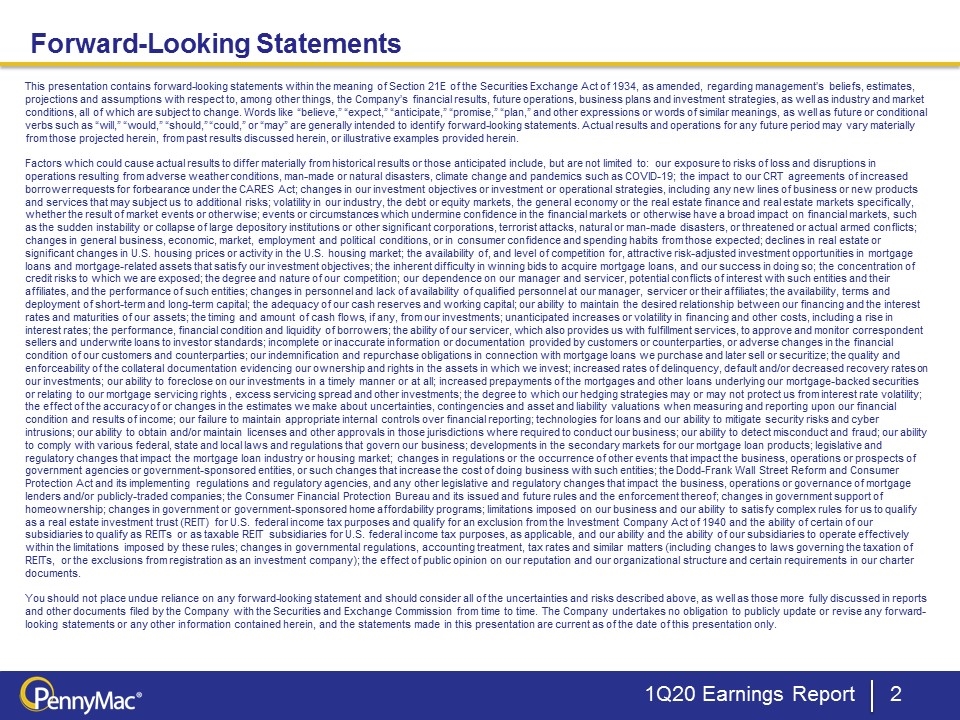
This presentation contains forward-looking statements within the meaning of Section 21E of the Securities Exchange Act of 1934, as amended, regarding management’s beliefs, estimates, projections and assumptions with respect to, among other things, the Company’s financial results, future operations, business plans and investment strategies, as well as industry and market conditions, all of which are subject to change. Words like “believe,” “expect,” “anticipate,” “promise,” “plan,” and other expressions or words of similar meanings, as well as future or conditional verbs such as “will,” “would,” “should,” “could,” or “may” are generally intended to identify forward-looking statements. Actual results and operations for any future period may vary materially from those projected herein, from past results discussed herein, or illustrative examples provided herein. Factors which could cause actual results to differ materially from historical results or those anticipated include, but are not limited to: our exposure to risks of loss and disruptions in operations resulting from adverse weather conditions, man-made or natural disasters, climate change and pandemics such as COVID-19; the impact to our CRT agreements of increased borrower requests for forbearance under the CARES Act; changes in our investment objectives or investment or operational strategies, including any new lines of business or new products and services that may subject us to additional risks; volatility in our industry, the debt or equity markets, the general economy or the real estate finance and real estate markets specifically, whether the result of market events or otherwise; events or circumstances which undermine confidence in the financial markets or otherwise have a broad impact on financial markets, such as the sudden instability or collapse of large depository institutions or other significant corporations, terrorist attacks, natural or man-made disasters, or threatened or actual armed conflicts; changes in general business, economic, market, employment and political conditions, or in consumer confidence and spending habits from those expected; declines in real estate or significant changes in U.S. housing prices or activity in the U.S. housing market; the availability of, and level of competition for, attractive risk-adjusted investment opportunities in mortgage loans and mortgage-related assets that satisfy our investment objectives; the inherent difficulty in winning bids to acquire mortgage loans, and our success in doing so; the concentration of credit risks to which we are exposed; the degree and nature of our competition; our dependence on our manager and servicer, potential conflicts of interest with such entities and their affiliates, and the performance of such entities; changes in personnel and lack of availability of qualified personnel at our manager, servicer or their affiliates; the availability, terms and deployment of short-term and long-term capital; the adequacy of our cash reserves and working capital; our ability to maintain the desired relationship between our financing and the interest rates and maturities of our assets; the timing and amount of cash flows, if any, from our investments; unanticipated increases or volatility in financing and other costs, including a rise in interest rates; the performance, financial condition and liquidity of borrowers; the ability of our servicer, which also provides us with fulfillment services, to approve and monitor correspondent sellers and underwrite loans to investor standards; incomplete or inaccurate information or documentation provided by customers or counterparties, or adverse changes in the financial condition of our customers and counterparties; our indemnification and repurchase obligations in connection with mortgage loans we purchase and later sell or securitize; the quality and enforceability of the collateral documentation evidencing our ownership and rights in the assets in which we invest; increased rates of delinquency, default and/or decreased recovery rates on our investments; our ability to foreclose on our investments in a timely manner or at all; increased prepayments of the mortgages and other loans underlying our mortgage-backed securities or relating to our mortgage servicing rights , excess servicing spread and other investments; the degree to which our hedging strategies may or may not protect us from interest rate volatility; the effect of the accuracy of or changes in the estimates we make about uncertainties, contingencies and asset and liability valuations when measuring and reporting upon our financial condition and results of income; our failure to maintain appropriate internal controls over financial reporting; technologies for loans and our ability to mitigate security risks and cyber intrusions; our ability to obtain and/or maintain licenses and other approvals in those jurisdictions where required to conduct our business; our ability to detect misconduct and fraud; our ability to comply with various federal, state and local laws and regulations that govern our business; developments in the secondary markets for our mortgage loan products; legislative and regulatory changes that impact the mortgage loan industry or housing market; changes in regulations or the occurrence of other events that impact the business, operations or prospects of government agencies or government-sponsored entities, or such changes that increase the cost of doing business with such entities; the Dodd-Frank Wall Street Reform and Consumer Protection Act and its implementing regulations and regulatory agencies, and any other legislative and regulatory changes that impact the business, operations or governance of mortgage lenders and/or publicly-traded companies; the Consumer Financial Protection Bureau and its issued and future rules and the enforcement thereof; changes in government support of homeownership; changes in government or government-sponsored home affordability programs; limitations imposed on our business and our ability to satisfy complex rules for us to qualify as a real estate investment trust (REIT) for U.S. federal income tax purposes and qualify for an exclusion from the Investment Company Act of 1940 and the ability of certain of our subsidiaries to qualify as REITs or as taxable REIT subsidiaries for U.S. federal income tax purposes, as applicable, and our ability and the ability of our subsidiaries to operate effectively within the limitations imposed by these rules; changes in governmental regulations, accounting treatment, tax rates and similar matters (including changes to laws governing the taxation of REITs, or the exclusions from registration as an investment company); the effect of public opinion on our reputation and our organizational structure and certain requirements in our charter documents. You should not place undue reliance on any forward-looking statement and should consider all of the uncertainties and risks described above, as well as those more fully discussed in reports and other documents filed by the Company with the Securities and Exchange Commission from time to time. The Company undertakes no obligation to publicly update or revise any forward-looking statements or any other information contained herein, and the statements made in this presentation are current as of the date of this presentation only. Forward-Looking Statements 1Q20 Earnings Report
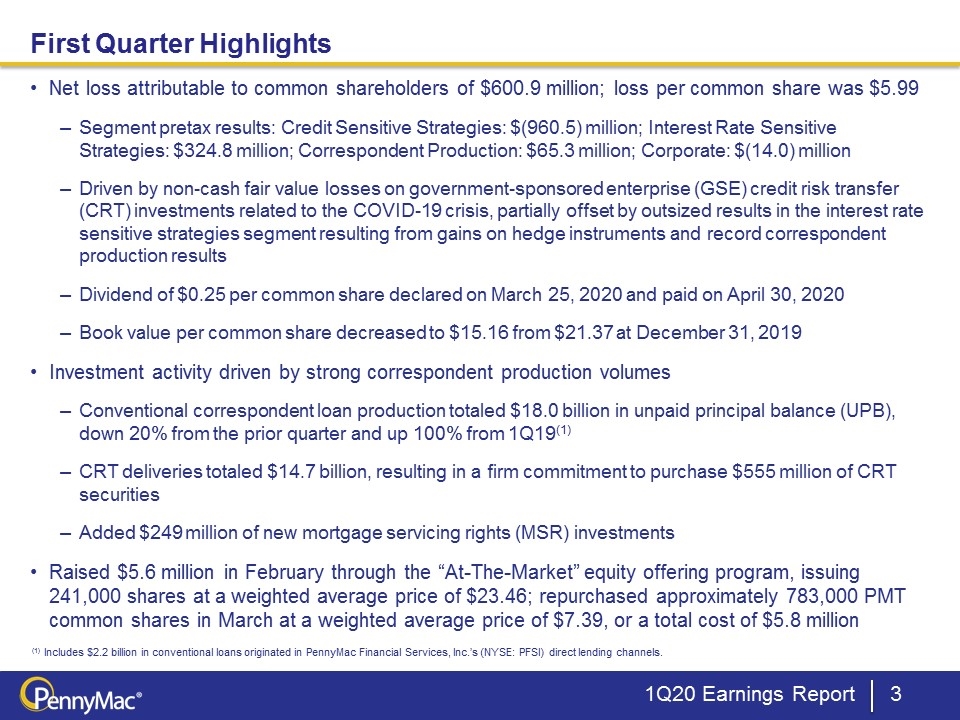
First Quarter Highlights 1Q20 Earnings Report (1) Includes $2.2 billion in conventional loans originated in PennyMac Financial Services, Inc.’s (NYSE: PFSI) direct lending channels. Net loss attributable to common shareholders of $600.9 million; loss per common share was $5.99 Segment pretax results: Credit Sensitive Strategies: $(960.5) million; Interest Rate Sensitive Strategies: $324.8 million; Correspondent Production: $65.3 million; Corporate: $(14.0) million Driven by non-cash fair value losses on government-sponsored enterprise (GSE) credit risk transfer (CRT) investments related to the COVID-19 crisis, partially offset by outsized results in the interest rate sensitive strategies segment resulting from gains on hedge instruments and record correspondent production results Dividend of $0.25 per common share declared on March 25, 2020 and paid on April 30, 2020 Book value per common share decreased to $15.16 from $21.37 at December 31, 2019 Investment activity driven by strong correspondent production volumes Conventional correspondent loan production totaled $18.0 billion in unpaid principal balance (UPB), down 20% from the prior quarter and up 100% from 1Q19(1) CRT deliveries totaled $14.7 billion, resulting in a firm commitment to purchase $555 million of CRT securities Added $249 million of new mortgage servicing rights (MSR) investments Raised $5.6 million in February through the “At-The-Market” equity offering program, issuing 241,000 shares at a weighted average price of $23.46; repurchased approximately 783,000 PMT common shares in March at a weighted average price of $7.39, or a total cost of $5.8 million
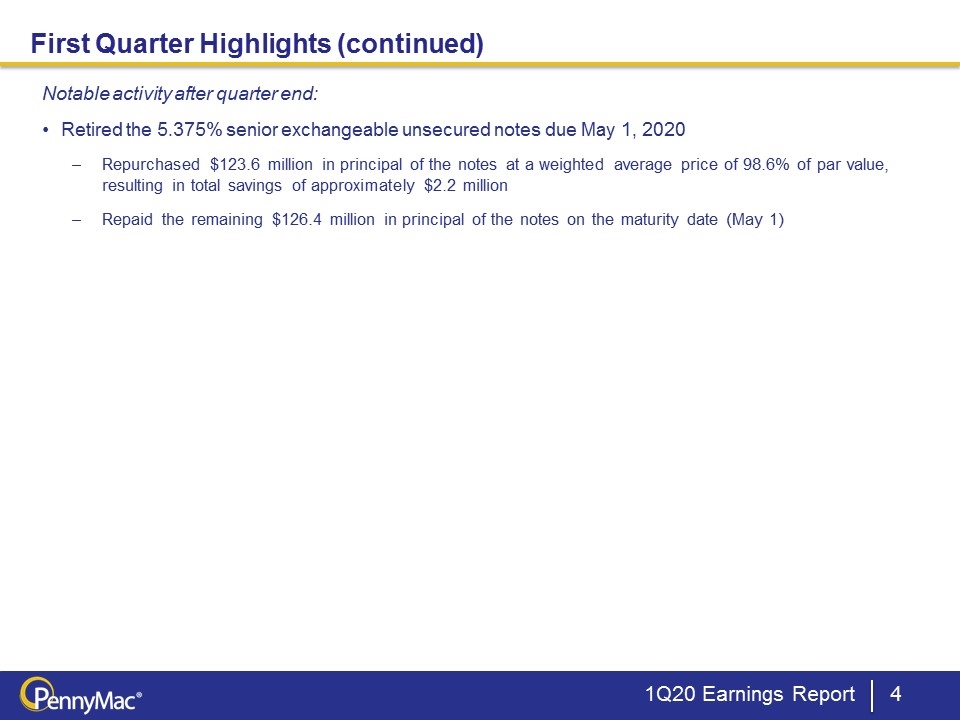
First Quarter Highlights (continued) 1Q20 Earnings Report Notable activity after quarter end: Retired the 5.375% senior exchangeable unsecured notes due May 1, 2020 Repurchased $123.6 million in principal of the notes at a weighted average price of 98.6% of par value, resulting in total savings of approximately $2.2 million Repaid the remaining $126.4 million in principal of the notes on the maturity date (May 1)
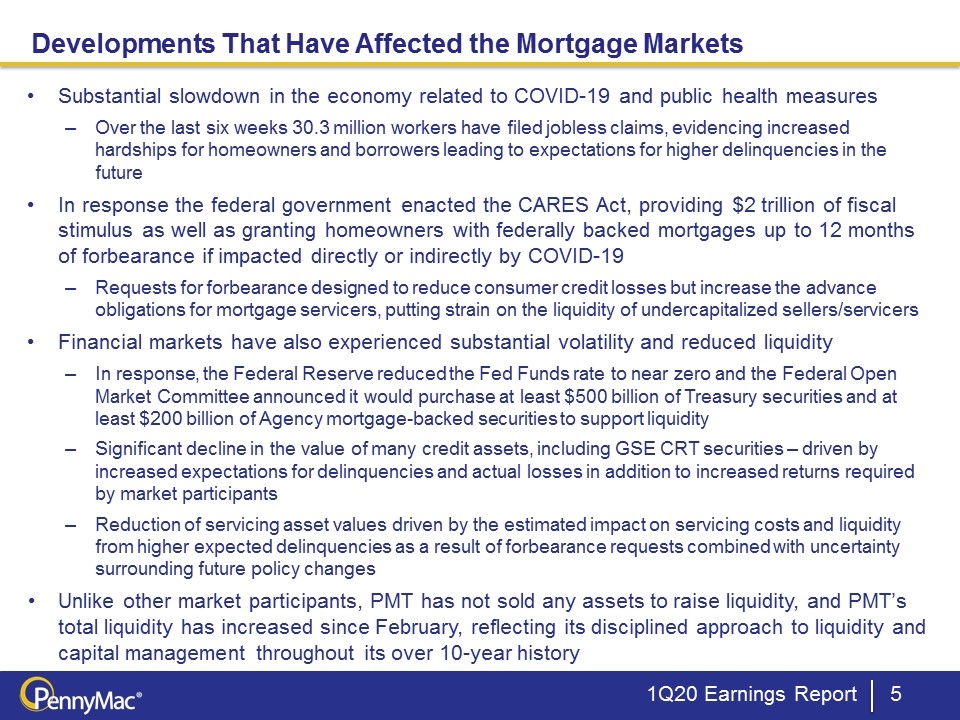
6 5 Developments That Have Affected the Mortgage Markets 1Q20 Earnings Report Substantial slowdown in the economy related to COVID-19 and public health measures Over the last six weeks 30.3 million workers have filed jobless claims, evidencing increased hardships for homeowners and borrowers leading to expectations for higher delinquencies in the future In response the federal government enacted the CARES Act, providing $2 trillion of fiscal stimulus as well as granting homeowners with federally backed mortgages up to 12 months of forbearance if impacted directly or indirectly by COVID-19 Requests for forbearance designed to reduce consumer credit losses but increase the advance obligations for mortgage servicers, putting strain on the liquidity of undercapitalized sellers/servicers Financial markets have also experienced substantial volatility and reduced liquidity In response, the Federal Reserve reduced the Fed Funds rate to near zero and the Federal Open Market Committee announced it would purchase at least $500 billion of Treasury securities and at least $200 billion of Agency mortgage-backed securities to support liquidity Significant decline in the value of many credit assets, including GSE CRT securities – driven by increased expectations for delinquencies and actual losses in addition to increased returns required by market participants Reduction of servicing asset values driven by the estimated impact on servicing costs and liquidity from higher expected delinquencies as a result of forbearance requests combined with uncertainty surrounding future policy changes Unlike other market participants, PMT has not sold any assets to raise liquidity, and PMT’s total liquidity has increased since February, reflecting its disciplined approach to liquidity and capital management throughout its over 10-year history

6 6 Mortgage Origination Market Update 1Q20 Earnings Report U.S. Mortgage Origination Market(1) (in billions) (1) Actual originations: Inside Mortgage Finance. Total originations forecast: Average of Mortgage Bankers Association (4/2/20), Fannie Mae (4/10/20), and Freddie Mac (4/13/20) forecasts (2) Freddie Mac Primary Mortgage Market Survey. 3.23% as of 4/30/20 Average 30-year fixed rate mortgage(2) 3.74% 3.50% Economic forecasts currently estimate total originations of $2.4 trillion in 2020, versus $2.3 trillion in 2019 Low rates continue to support robust refinance volumes while stay-at-home orders have resulted in a decline in expected purchase activity Refinance demand in April has remained elevated The primary/secondary spread is expected to remain wide for an extended period of time Some originators and aggregators experienced challenges in secondary market execution and/or pipeline hedging due to the market volatility Certain competitors, primarily in the broker and correspondent lending channels, have reduced or limited their participation due to operational, liquidity and capital issues As a result of its risk management, mortgage market expertise, capital advantages and scale, PennyMac has continuously originated, funded and settled loans throughout the crisis
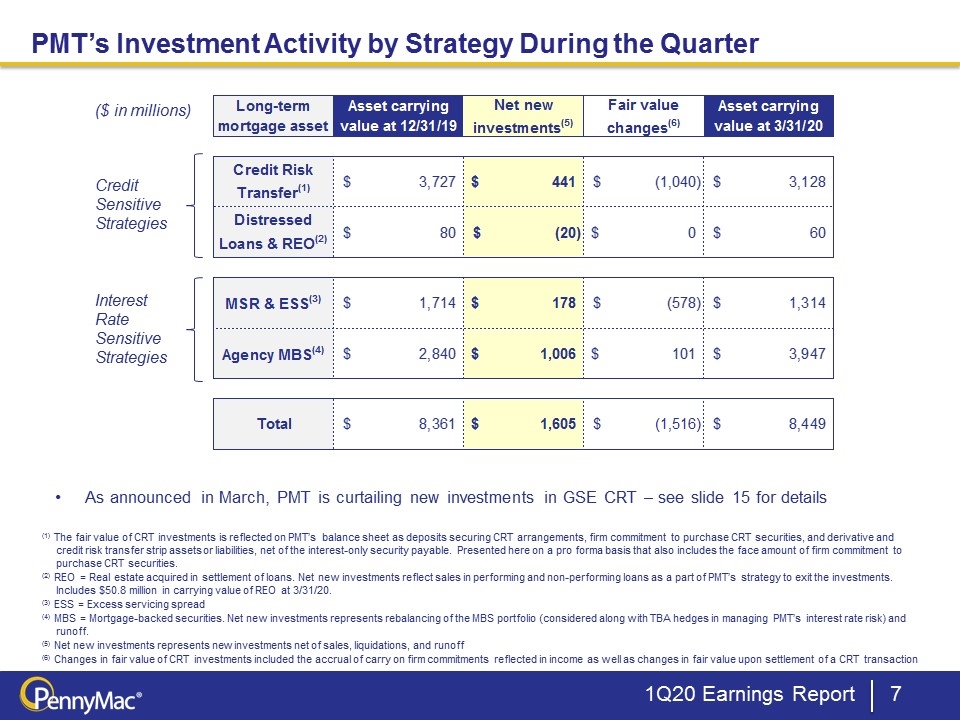
PMT’s Investment Activity by Strategy During the Quarter (1) The fair value of CRT investments is reflected on PMT’s balance sheet as deposits securing CRT arrangements, firm commitment to purchase CRT securities, and derivative and credit risk transfer strip assets or liabilities, net of the interest-only security payable. Presented here on a pro forma basis that also includes the face amount of firm commitment to purchase CRT securities. (2) REO = Real estate acquired in settlement of loans. Net new investments reflect sales in performing and non-performing loans as a part of PMT’s strategy to exit the investments. Includes $50.8 million in carrying value of REO at 3/31/20. (3) ESS = Excess servicing spread (4) MBS = Mortgage-backed securities. Net new investments represents rebalancing of the MBS portfolio (considered along with TBA hedges in managing PMT’s interest rate risk) and runoff. (5) Net new investments represents new investments net of sales, liquidations, and runoff (6) Changes in fair value of CRT investments included the accrual of carry on firm commitments reflected in income as well as changes in fair value upon settlement of a CRT transaction Credit Sensitive Strategies Interest Rate Sensitive Strategies ($ in millions) 1Q20 Earnings Report As announced in March, PMT is curtailing new investments in GSE CRT – see slide 15 for details
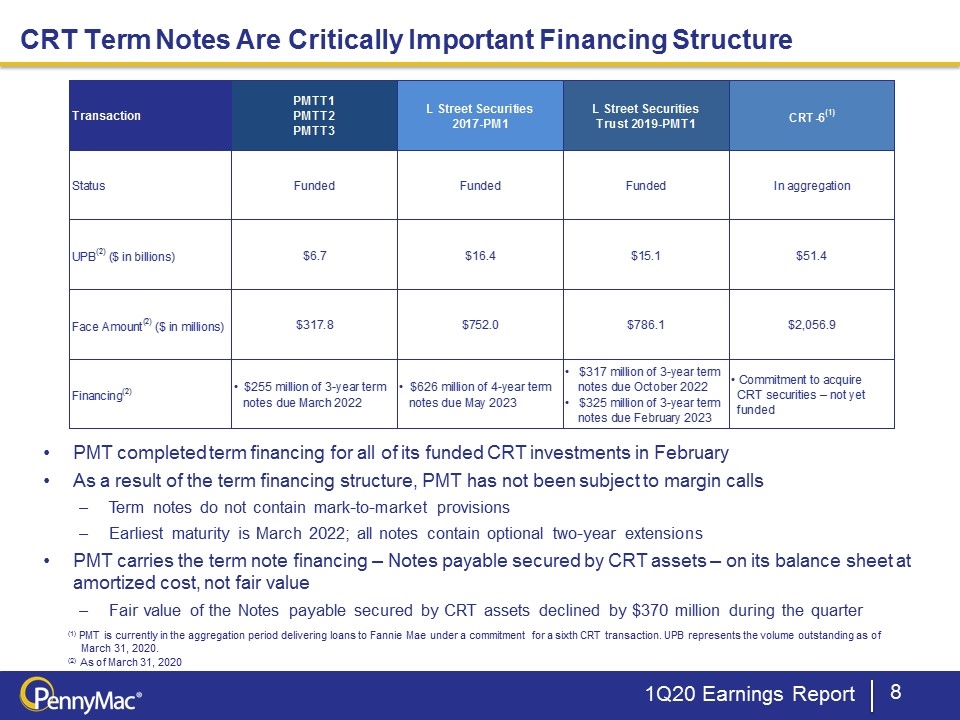
CRT Term Notes Are Critically Important Financing Structure 1Q20 Earnings Report (1) PMT is currently in the aggregation period delivering loans to Fannie Mae under a commitment for a sixth CRT transaction. UPB represents the volume outstanding as of March 31, 2020. (2) As of March 31, 2020 PMT completed term financing for all of its funded CRT investments in February As a result of the term financing structure, PMT has not been subject to margin calls Term notes do not contain mark-to-market provisions Earliest maturity is March 2022; all notes contain optional two-year extensions PMT carries the term note financing – Notes payable secured by CRT assets – on its balance sheet at amortized cost, not fair value Fair value of the Notes payable secured by CRT assets declined by $370 million during the quarter
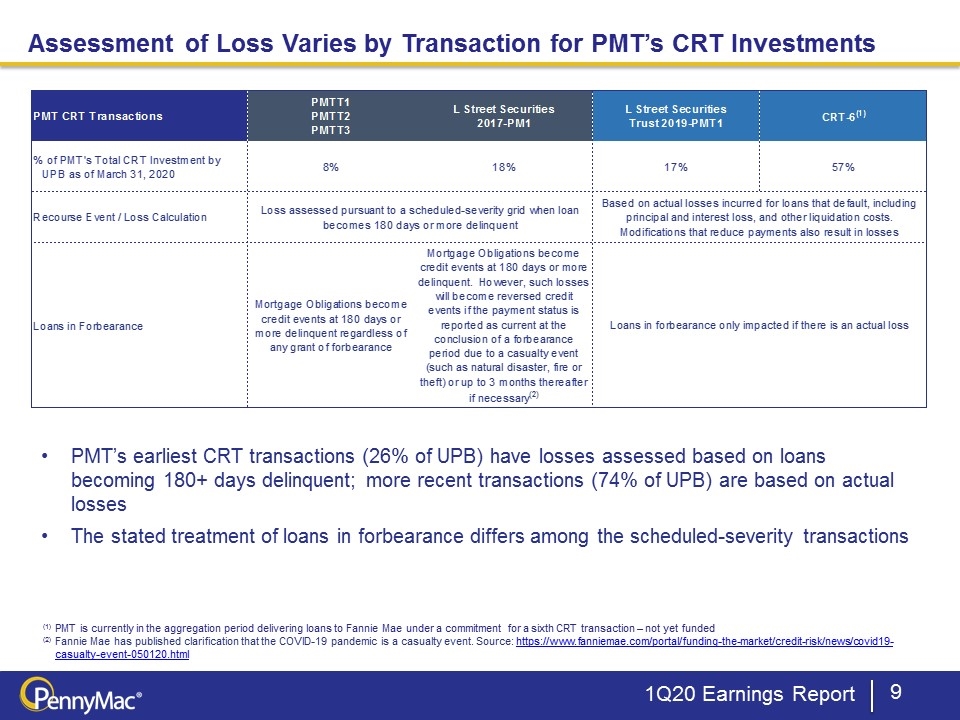
Assessment of Loss Varies by Transaction for PMT’s CRT Investments 1Q20 Earnings Report PMT’s earliest CRT transactions (26% of UPB) have losses assessed based on loans becoming 180+ days delinquent; more recent transactions (74% of UPB) are based on actual losses The stated treatment of loans in forbearance differs among the scheduled-severity transactions (1) PMT is currently in the aggregation period delivering loans to Fannie Mae under a commitment for a sixth CRT transaction – not yet funded (2) Fannie Mae has published clarification that the COVID-19 pandemic is a casualty event. Source: https://www.fanniemae.com/portal/funding-the-market/credit-risk/news/covid19-casualty-event-050120.html
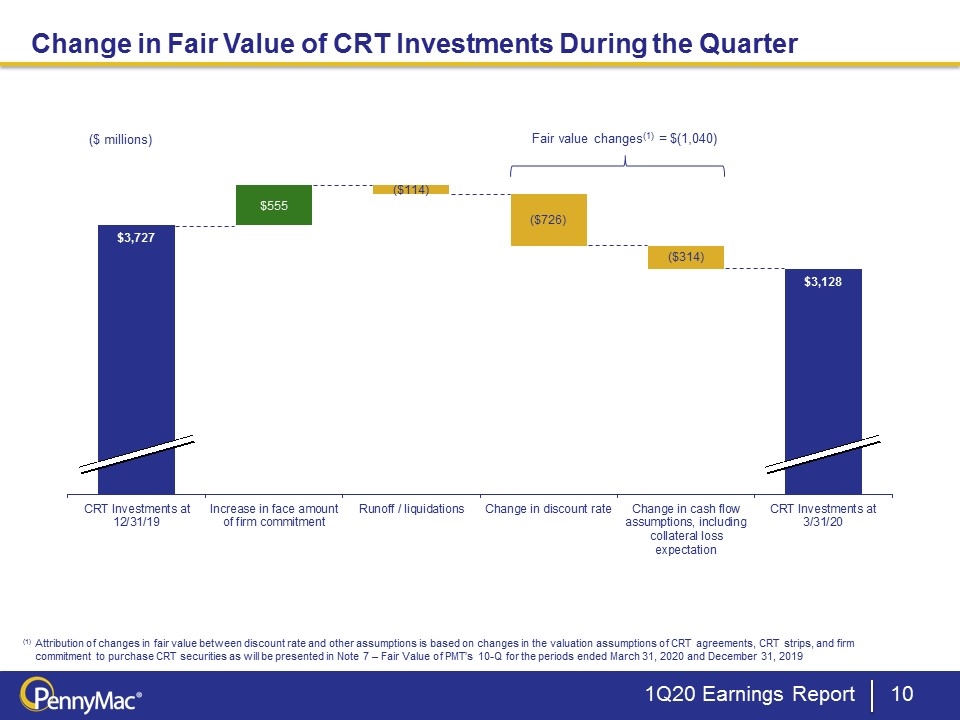
Change in Fair Value of CRT Investments During the Quarter 1Q20 Earnings Report ($ millions) Fair value changes(1) = $(1,040) (1) Attribution of changes in fair value between discount rate and other assumptions is based on changes in the valuation assumptions of CRT agreements, CRT strips, and firm commitment to purchase CRT securities as will be presented in Note 7 – Fair Value of PMT’s 10-Q for the periods ended March 31, 2020 and December 31, 2019
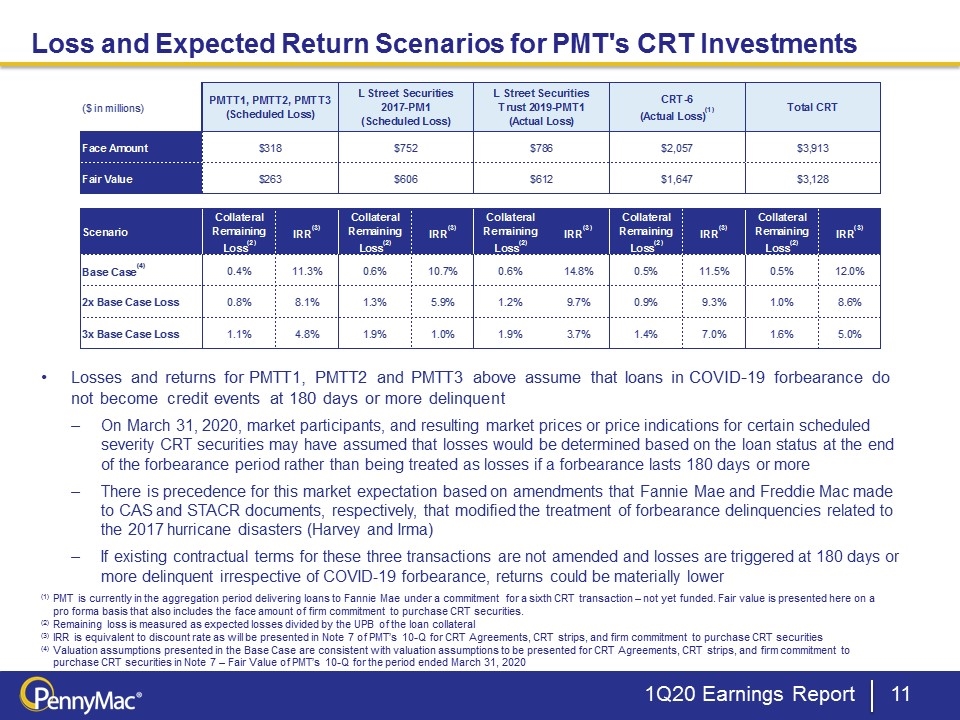
Loss and Expected Return Scenarios for PMT's CRT Investments 1Q20 Earnings Report Losses and returns for PMTT1, PMTT2 and PMTT3 above assume that loans in COVID-19 forbearance do not become credit events at 180 days or more delinquent On March 31, 2020, market participants, and resulting market prices or price indications for certain scheduled severity CRT securities may have assumed that losses would be determined based on the loan status at the end of the forbearance period rather than being treated as losses if a forbearance lasts 180 days or more There is precedence for this market expectation based on amendments that Fannie Mae and Freddie Mac made to CAS and STACR documents, respectively, that modified the treatment of forbearance delinquencies related to the 2017 hurricane disasters (Harvey and Irma) If existing contractual terms for these three transactions are not amended and losses are triggered at 180 days or more delinquent irrespective of COVID-19 forbearance, returns could be materially lower (1) PMT is currently in the aggregation period delivering loans to Fannie Mae under a commitment for a sixth CRT transaction – not yet funded. Fair value is presented here on a pro forma basis that also includes the face amount of firm commitment to purchase CRT securities. (2) Remaining loss is measured as expected losses divided by the UPB of the loan collateral (3) IRR is equivalent to discount rate as will be presented in Note 7 of PMT’s 10-Q for CRT Agreements, CRT strips, and firm commitment to purchase CRT securities (4) Valuation assumptions presented in the Base Case are consistent with valuation assumptions to be presented for CRT Agreements, CRT strips, and firm commitment to purchase CRT securities in Note 7 – Fair Value of PMT’s 10-Q for the period ended March 31, 2020
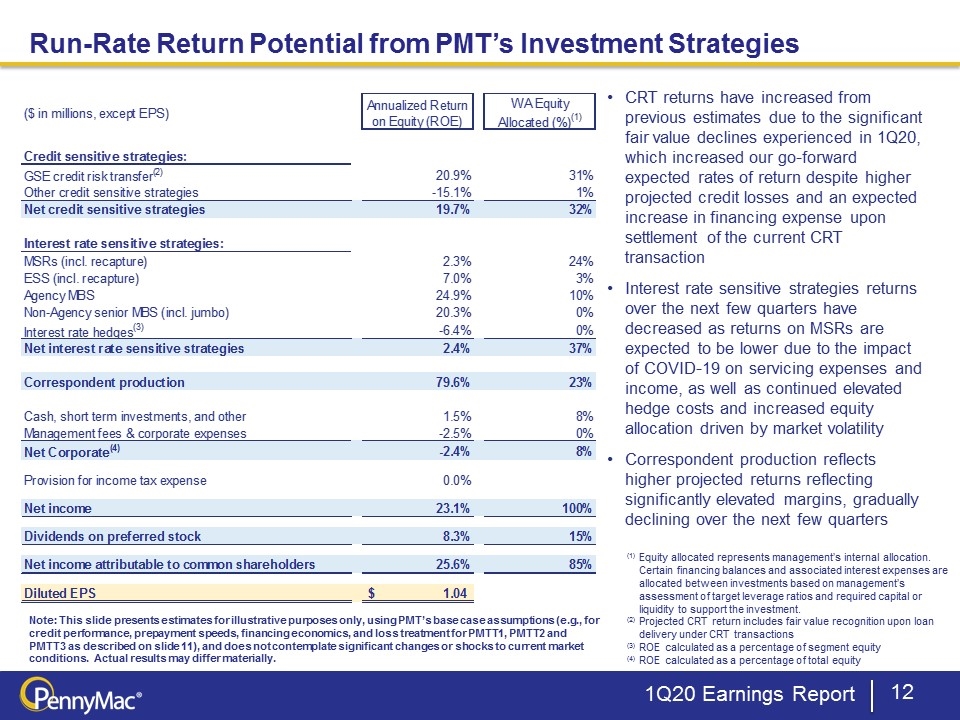
Run-Rate Return Potential from PMT’s Investment Strategies 1Q20 Earnings Report Note: This slide presents estimates for illustrative purposes only, using PMT’s base case assumptions (e.g., for credit performance, prepayment speeds, financing economics, and loss treatment for PMTT1, PMTT2 and PMTT3 as described on slide 11), and does not contemplate significant changes or shocks to current market conditions. Actual results may differ materially. (1) Equity allocated represents management’s internal allocation. Certain financing balances and associated interest expenses are allocated between investments based on management’s assessment of target leverage ratios and required capital or liquidity to support the investment. (2) Projected CRT return includes fair value recognition upon loan delivery under CRT transactions (3) ROE calculated as a percentage of segment equity (4) ROE calculated as a percentage of total equity CRT returns have increased from previous estimates due to the significant fair value declines experienced in 1Q20, which increased our go-forward expected rates of return despite higher projected credit losses and an expected increase in financing expense upon settlement of the current CRT transaction Interest rate sensitive strategies returns over the next few quarters have decreased as returns on MSRs are expected to be lower due to the impact of COVID-19 on servicing expenses and income, as well as continued elevated hedge costs and increased equity allocation driven by market volatility Correspondent production reflects higher projected returns reflecting significantly elevated margins, gradually declining over the next few quarters
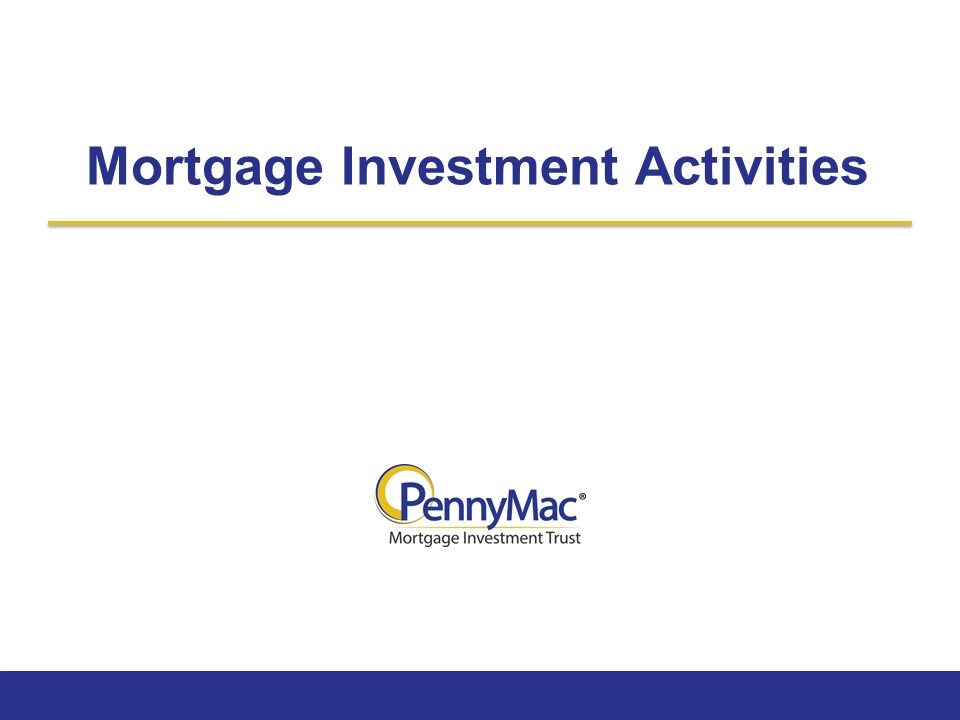
Mortgage Investment Activities
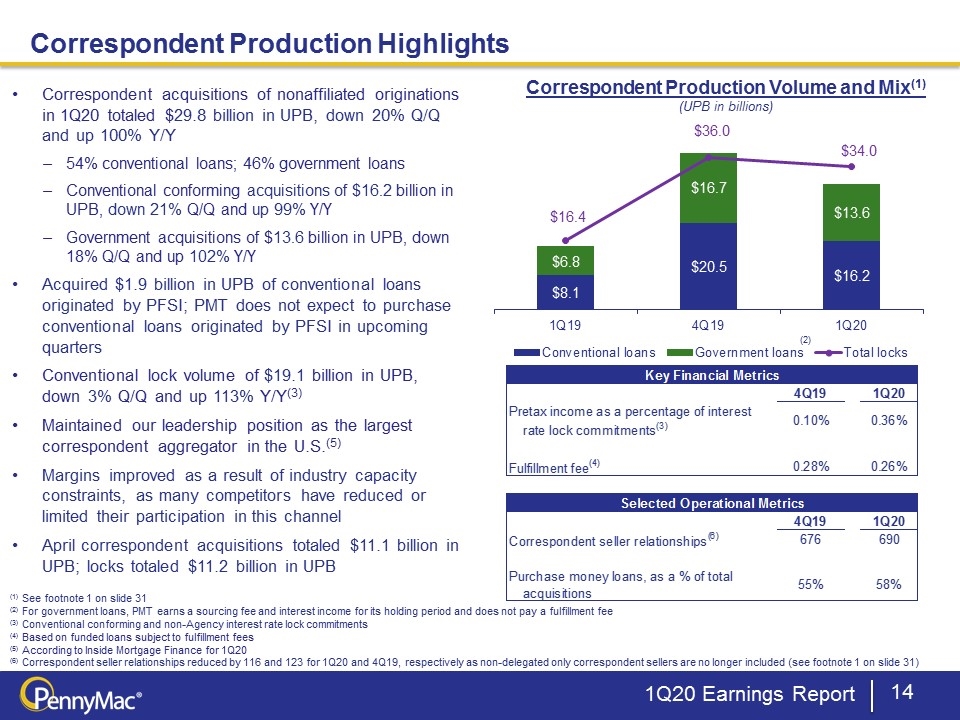
Correspondent Production Highlights 1Q20 Earnings Report Correspondent Production Volume and Mix(1) (UPB in billions) (1) See footnote 1 on slide 31 (2) For government loans, PMT earns a sourcing fee and interest income for its holding period and does not pay a fulfillment fee (3) Conventional conforming and non-Agency interest rate lock commitments (4) Based on funded loans subject to fulfillment fees (5) According to Inside Mortgage Finance for 1Q20 (6) Correspondent seller relationships reduced by 116 and 123 for 1Q20 and 4Q19, respectively as non-delegated only correspondent sellers are no longer included (see footnote 1 on slide 31) (2) Correspondent acquisitions of nonaffiliated originations in 1Q20 totaled $29.8 billion in UPB, down 20% Q/Q and up 100% Y/Y 54% conventional loans; 46% government loans Conventional conforming acquisitions of $16.2 billion in UPB, down 21% Q/Q and up 99% Y/Y Government acquisitions of $13.6 billion in UPB, down 18% Q/Q and up 102% Y/Y Acquired $1.9 billion in UPB of conventional loans originated by PFSI; PMT does not expect to purchase conventional loans originated by PFSI in upcoming quarters Conventional lock volume of $19.1 billion in UPB, down 3% Q/Q and up 113% Y/Y(3) Maintained our leadership position as the largest correspondent aggregator in the U.S.(5) Margins improved as a result of industry capacity constraints, as many competitors have reduced or limited their participation in this channel April correspondent acquisitions totaled $11.1 billion in UPB; locks totaled $11.2 billion in UPB
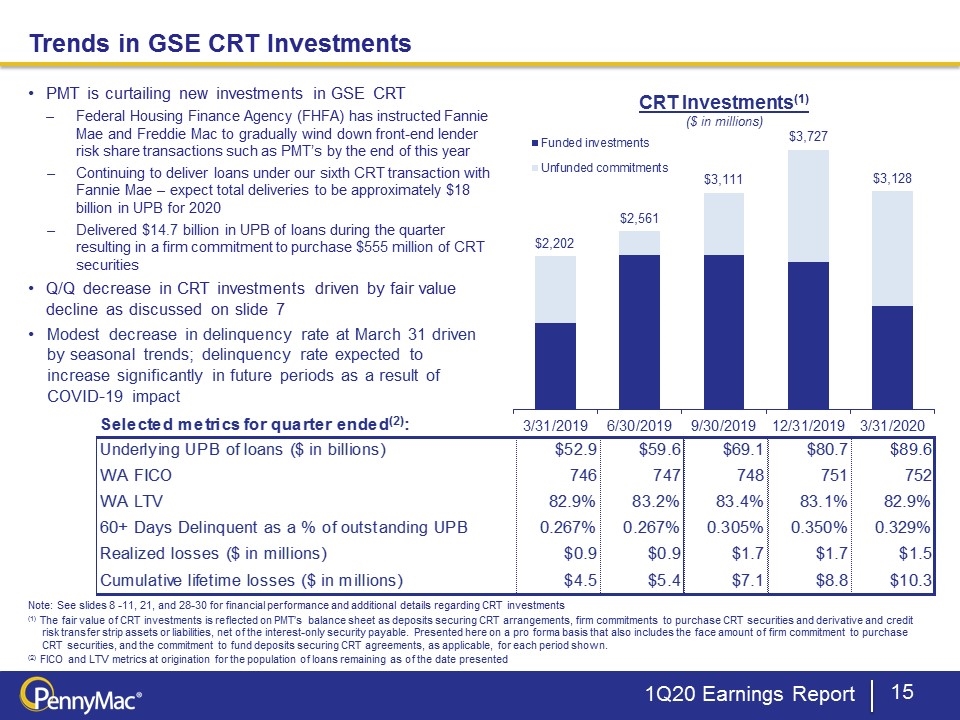
Trends in GSE CRT Investments PMT is curtailing new investments in GSE CRT Federal Housing Finance Agency (FHFA) has instructed Fannie Mae and Freddie Mac to gradually wind down front-end lender risk share transactions such as PMT’s by the end of this year Continuing to deliver loans under our sixth CRT transaction with Fannie Mae – expect total deliveries to be approximately $18 billion in UPB for 2020 Delivered $14.7 billion in UPB of loans during the quarter resulting in a firm commitment to purchase $555 million of CRT securities Q/Q decrease in CRT investments driven by fair value decline as discussed on slide 7 Modest decrease in delinquency rate at March 31 driven by seasonal trends; delinquency rate expected to increase significantly in future periods as a result of COVID-19 impact Note: See slides 8 -11, 21, and 28-30 for financial performance and additional details regarding CRT investments (1) The fair value of CRT investments is reflected on PMT’s balance sheet as deposits securing CRT arrangements, firm commitments to purchase CRT securities and derivative and credit risk transfer strip assets or liabilities, net of the interest-only security payable. Presented here on a pro forma basis that also includes the face amount of firm commitment to purchase CRT securities, and the commitment to fund deposits securing CRT agreements, as applicable, for each period shown. (2) FICO and LTV metrics at origination for the population of loans remaining as of the date presented CRT Investments(1) ($ in millions) 1Q20 Earnings Report
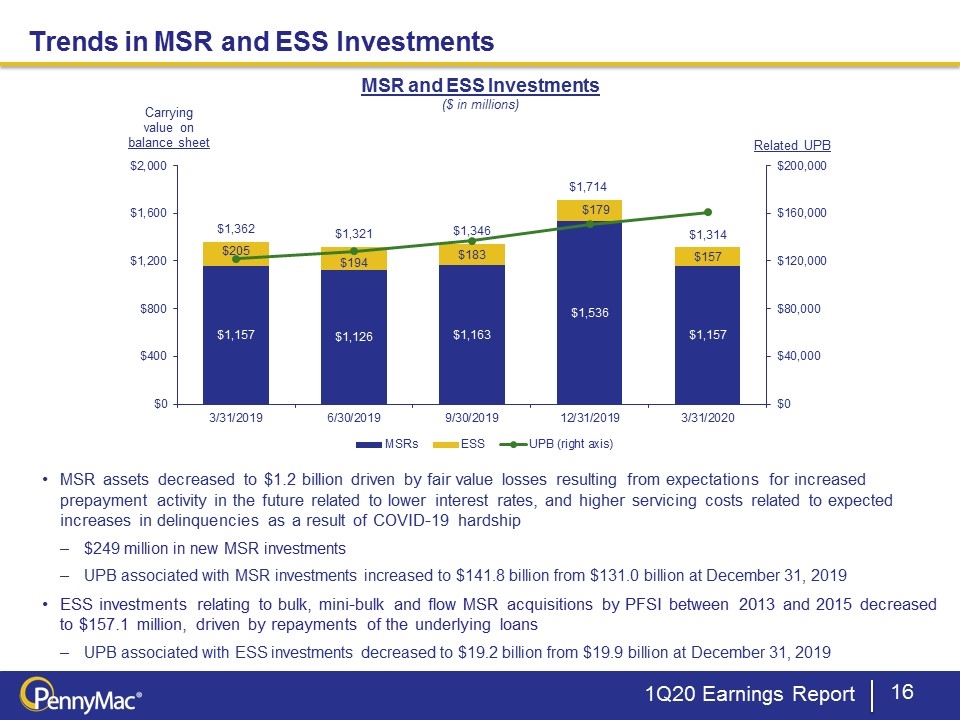
MSR assets decreased to $1.2 billion driven by fair value losses resulting from expectations for increased prepayment activity in the future related to lower interest rates, and higher servicing costs related to expected increases in delinquencies as a result of COVID-19 hardship $249 million in new MSR investments UPB associated with MSR investments increased to $141.8 billion from $131.0 billion at December 31, 2019 ESS investments relating to bulk, mini-bulk and flow MSR acquisitions by PFSI between 2013 and 2015 decreased to $157.1 million, driven by repayments of the underlying loans UPB associated with ESS investments decreased to $19.2 billion from $19.9 billion at December 31, 2019 MSR and ESS Investments ($ in millions) Trends in MSR and ESS Investments 1Q20 Earnings Report

PMT’s Estimated Sensitivity to Changes in Interest Rates 1Q20 Earnings Report % change in PMT’s shareholders’ equity Instantaneous parallel shock in interest rates (in bps) % change in PMT’s shareholders’ equity Instantaneous parallel shock in interest rates (in bps) Throughout the first quarter, PMT’s net exposure to changes in interest rates changed meaningfully as the hedge profile was adjusted to address the significant interest rate volatility PMT’s hedge profile seeks to protect against the risk of significant fair value changes as well as timing-driven liquidity impacts, which led to a profile positioned for gains in the event of large interest rate changes Improved correspondent production margins provided the ability to purchase increased option-based coverage In part, the additional option-based coverage was established to hedge the interest rate sensitivity of PMT’s CRT investments (1) (2) (3) (1) (2) (3) (1) Includes loans acquired for sale and IRLCs, net of associated hedges, and Agency and Non-Agency MBS Assets (2) Includes MSRs, ESS, and hedges which include put and call options on MBS, Eurodollar futures, Treasury futures, and Exchange-traded swaps (3) Net exposure represents the net position of the “Long” Assets and the MSRs/ESS and Hedges At 12/31/19 At 3/31/20
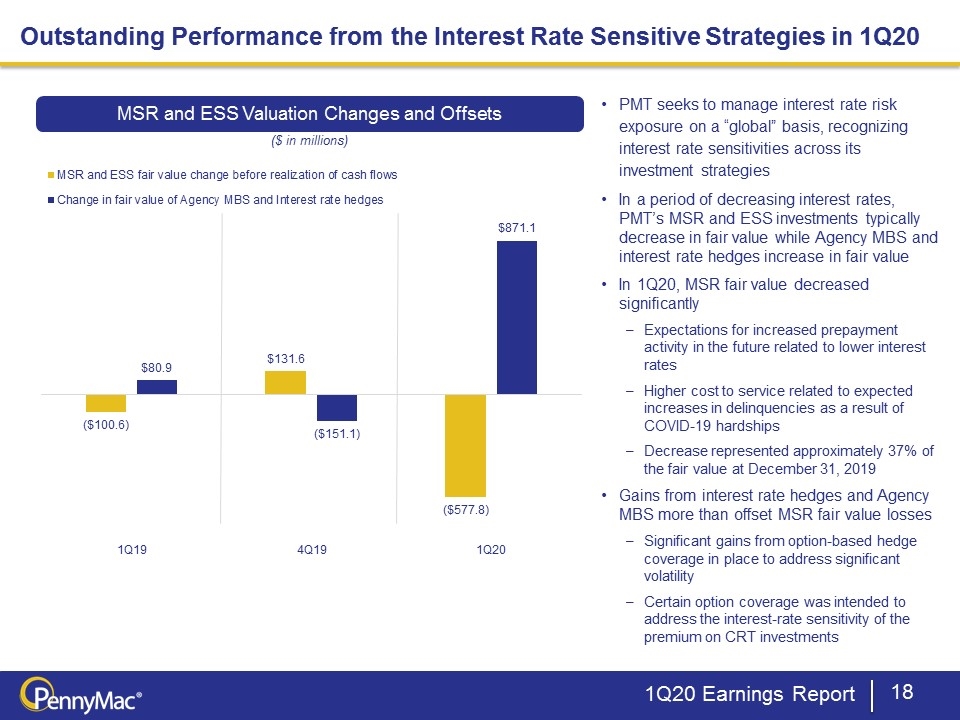
Outstanding Performance from the Interest Rate Sensitive Strategies in 1Q20 1Q20 Earnings Report PMT seeks to manage interest rate risk exposure on a “global” basis, recognizing interest rate sensitivities across its investment strategies In a period of decreasing interest rates, PMT’s MSR and ESS investments typically decrease in fair value while Agency MBS and interest rate hedges increase in fair value In 1Q20, MSR fair value decreased significantly Expectations for increased prepayment activity in the future related to lower interest rates Higher cost to service related to expected increases in delinquencies as a result of COVID-19 hardships Decrease represented approximately 37% of the fair value at December 31, 2019 Gains from interest rate hedges and Agency MBS more than offset MSR fair value losses Significant gains from option-based hedge coverage in place to address significant volatility Certain option coverage was intended to address the interest-rate sensitivity of the premium on CRT investments MSR and ESS Valuation Changes and Offsets ($ in millions)

Financial Results
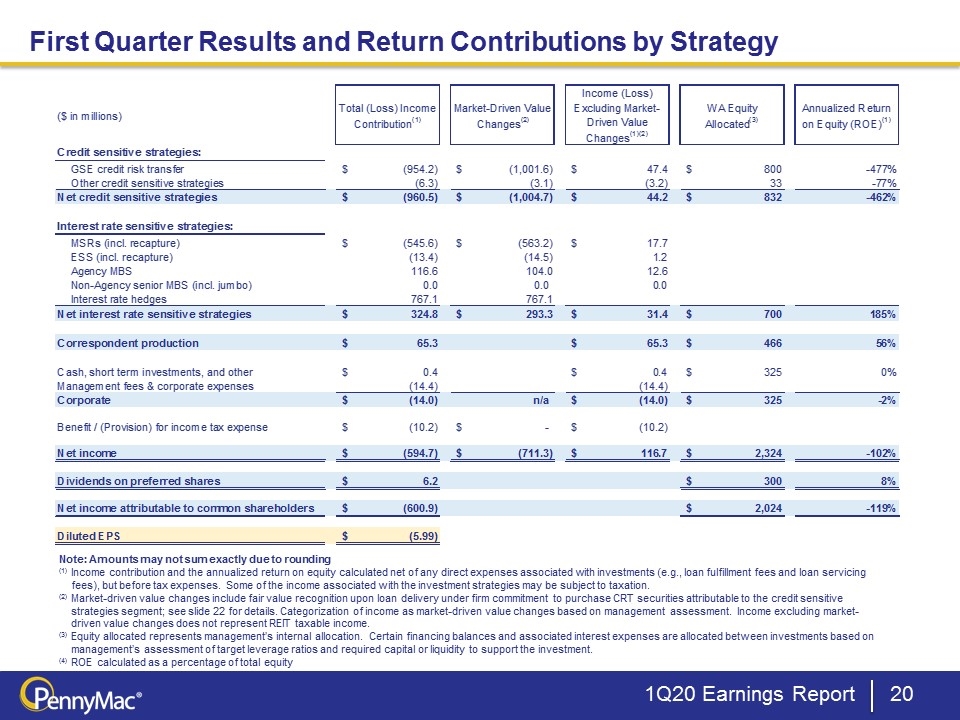
Note: Amounts may not sum exactly due to rounding (1) Income contribution and the annualized return on equity calculated net of any direct expenses associated with investments (e.g., loan fulfillment fees and loan servicing fees), but before tax expenses. Some of the income associated with the investment strategies may be subject to taxation. (2) Market-driven value changes include fair value recognition upon loan delivery under firm commitment to purchase CRT securities attributable to the credit sensitive strategies segment; see slide 22 for details. Categorization of income as market-driven value changes based on management assessment. Income excluding market-driven value changes does not represent REIT taxable income. (3) Equity allocated represents management’s internal allocation. Certain financing balances and associated interest expenses are allocated between investments based on management’s assessment of target leverage ratios and required capital or liquidity to support the investment. (4) ROE calculated as a percentage of total equity First Quarter Results and Return Contributions by Strategy 1Q20 Earnings Report
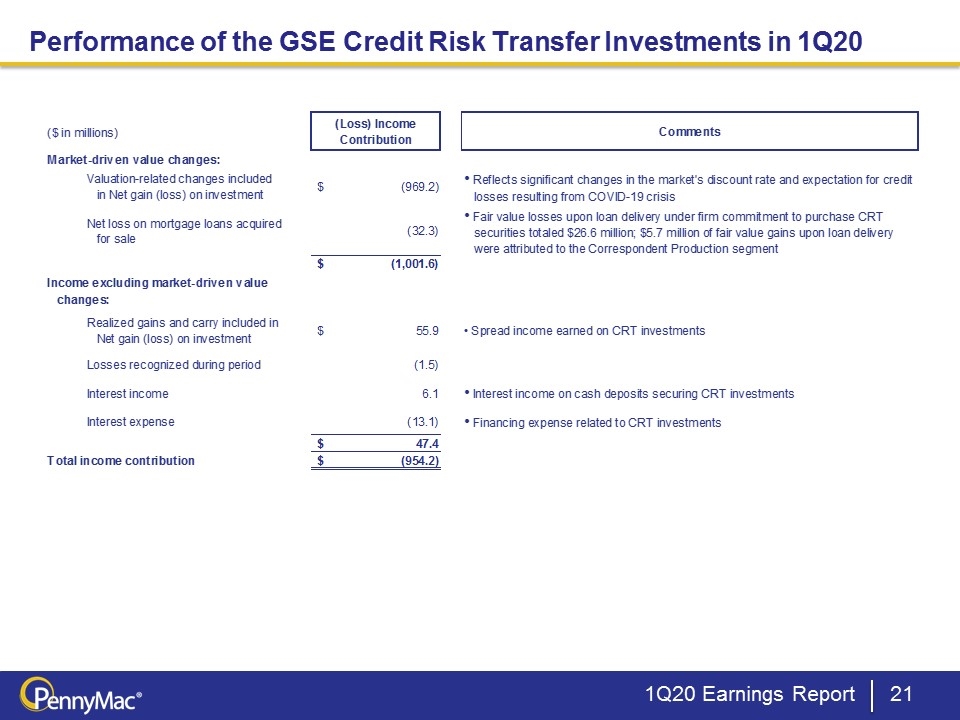
Performance of the GSE Credit Risk Transfer Investments in 1Q20 1Q20 Earnings Report
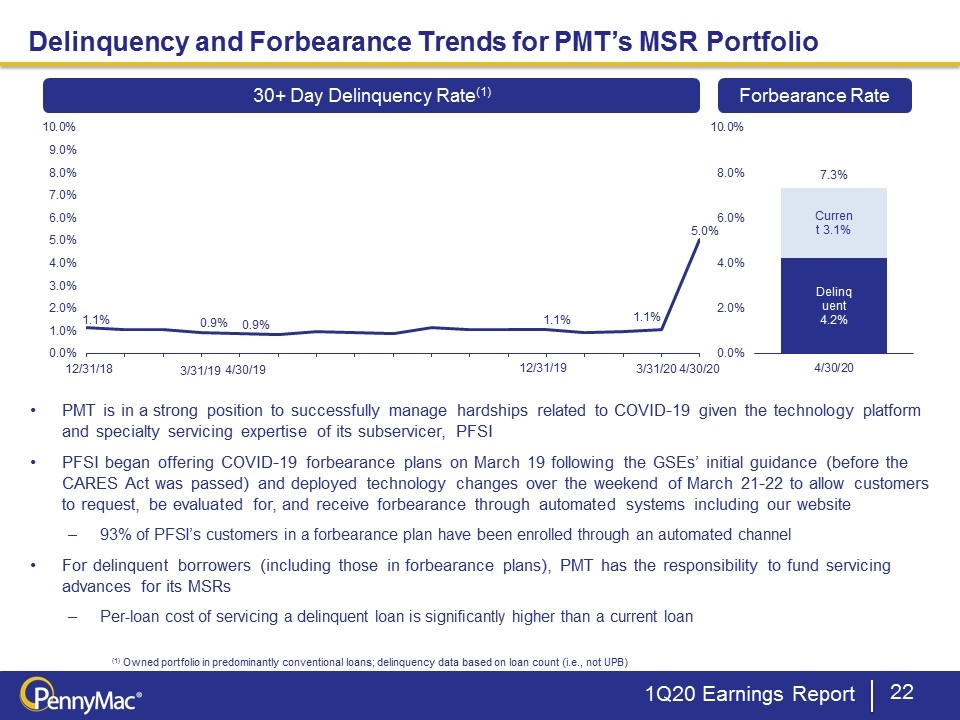
Delinquency and Forbearance Trends for PMT’s MSR Portfolio 1Q20 Earnings Report PMT is in a strong position to successfully manage hardships related to COVID-19 given the technology platform and specialty servicing expertise of its subservicer, PFSI PFSI began offering COVID-19 forbearance plans on March 19 following the GSEs’ initial guidance (before the CARES Act was passed) and deployed technology changes over the weekend of March 21-22 to allow customers to request, be evaluated for, and receive forbearance through automated systems including our website 93% of PFSI’s customers in a forbearance plan have been enrolled through an automated channel For delinquent borrowers (including those in forbearance plans), PMT has the responsibility to fund servicing advances for its MSRs Per-loan cost of servicing a delinquent loan is significantly higher than a current loan 30+ Day Delinquency Rate(1) Forbearance Rate (1) Owned portfolio in predominantly conventional loans; delinquency data based on loan count (i.e., not UPB) 12/31/18 3/31/19 4/30/19 12/31/19 3/31/20 4/30/20

Servicing Advance Requirements 1Q20 Earnings Report Fannie Mae requires a servicer to continue advancing principal and interest (P&I) payments for delinquent loans and Freddie Mac requires a servicer to continue advancing interest for only four months These P&I advances are typically covered by prepayment activity, except in adverse scenarios where high delinquency rates combine with extended average periods of delinquency The majority of advances related to PMT’s Agency MSR portfolio are expected to be related to property taxes and insurance to protect investors’ interest in the property collateralizing the mortgages Advance balance projections could increase if recoveries of advances from borrowers or guaranteeing agencies are prolonged or delayed significantly after borrower reinstatement or loan modification PMT has historically funded any required servicing advances with corporate cash Servicing advances outstanding were $34 million at April 30, 2020 PMT has $1.6 billion in available liquidity(1), less $100 million in minimum liquidity covenants, as of April 30, 2020 (1) Available liquidity is defined as cash on hand plus the amount that can be immediately borrowed with available collateral
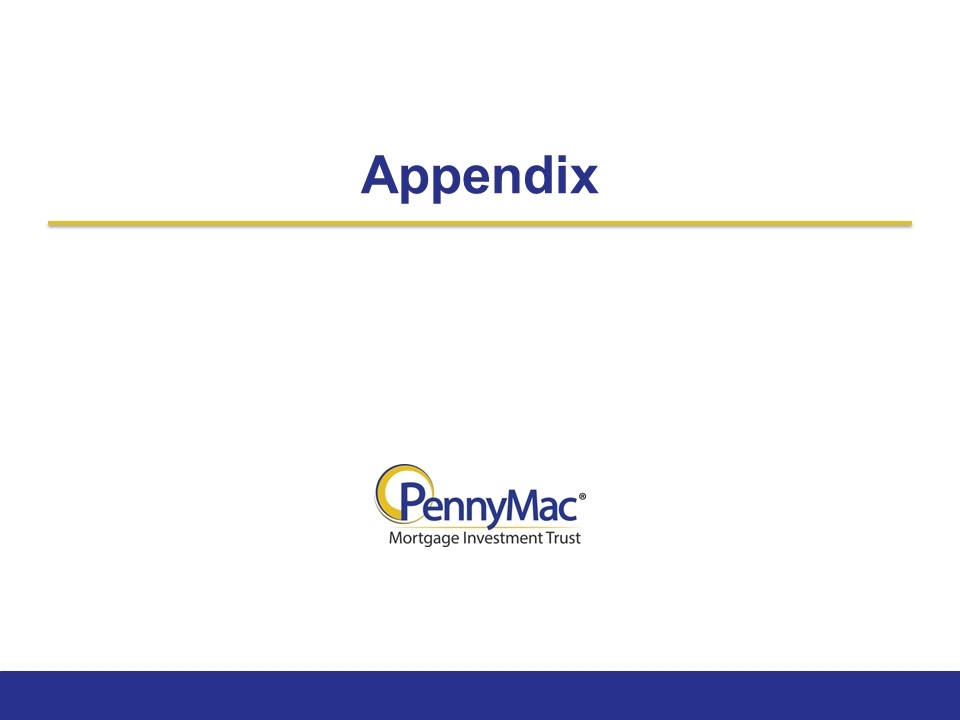
Appendix
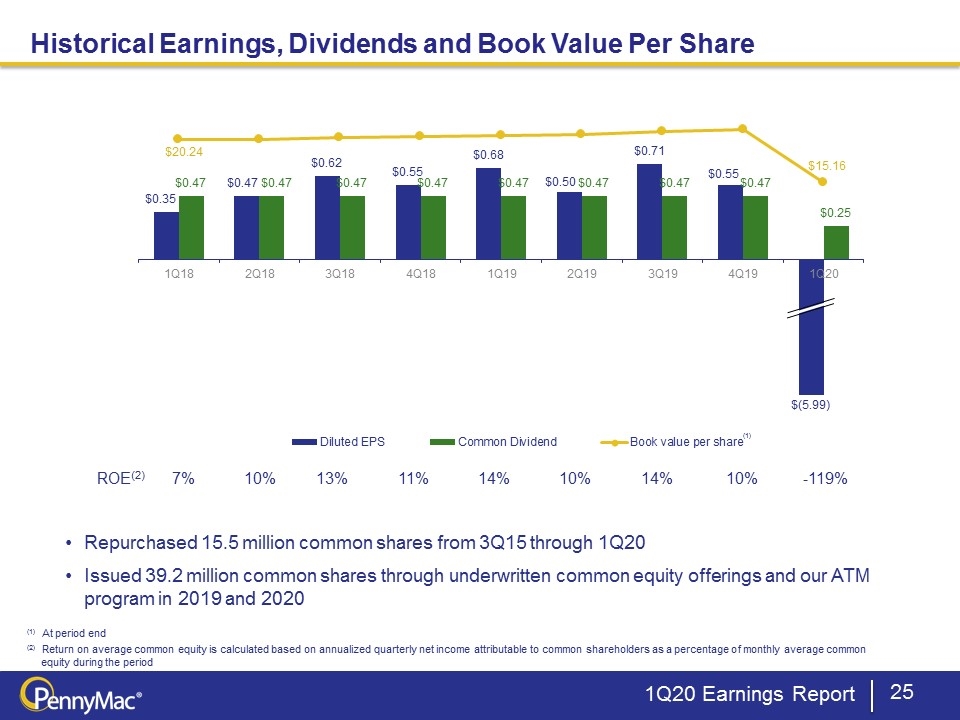
(1) At period end (2) Return on average common equity is calculated based on annualized quarterly net income attributable to common shareholders as a percentage of monthly average common equity during the period Historical Earnings, Dividends and Book Value Per Share Repurchased 15.5 million common shares from 3Q15 through 1Q20 Issued 39.2 million common shares through underwritten common equity offerings and our ATM program in 2019 and 2020 ROE(2) 7% 10% 13% 11% 14% 10% 14% 10% -119% 1Q20 Earnings Report (1) $(5.99)
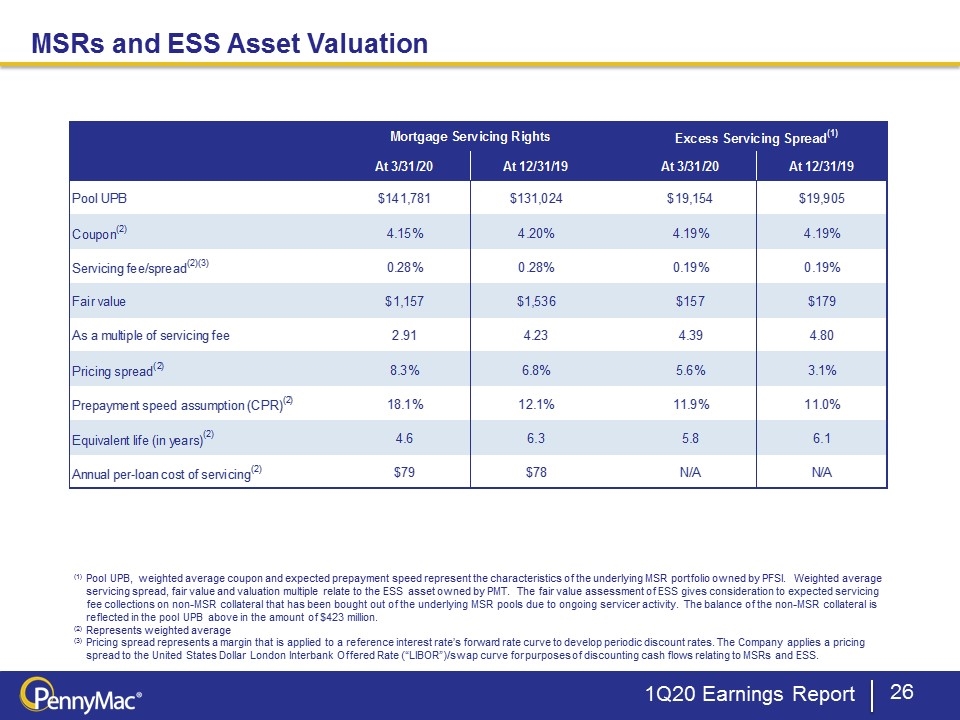
MSRs and ESS Asset Valuation Unaudited (1) Pool UPB, weighted average coupon and expected prepayment speed represent the characteristics of the underlying MSR portfolio owned by PFSI. Weighted average servicing spread, fair value and valuation multiple relate to the ESS asset owned by PMT. The fair value assessment of ESS gives consideration to expected servicing fee collections on non-MSR collateral that has been bought out of the underlying MSR pools due to ongoing servicer activity. The balance of the non-MSR collateral is reflected in the pool UPB above in the amount of $423 million. (2) Represents weighted average (3) Pricing spread represents a margin that is applied to a reference interest rate’s forward rate curve to develop periodic discount rates. The Company applies a pricing spread to the United States Dollar London Interbank Offered Rate (“LIBOR”)/swap curve for purposes of discounting cash flows relating to MSRs and ESS. 1Q20 Earnings Report
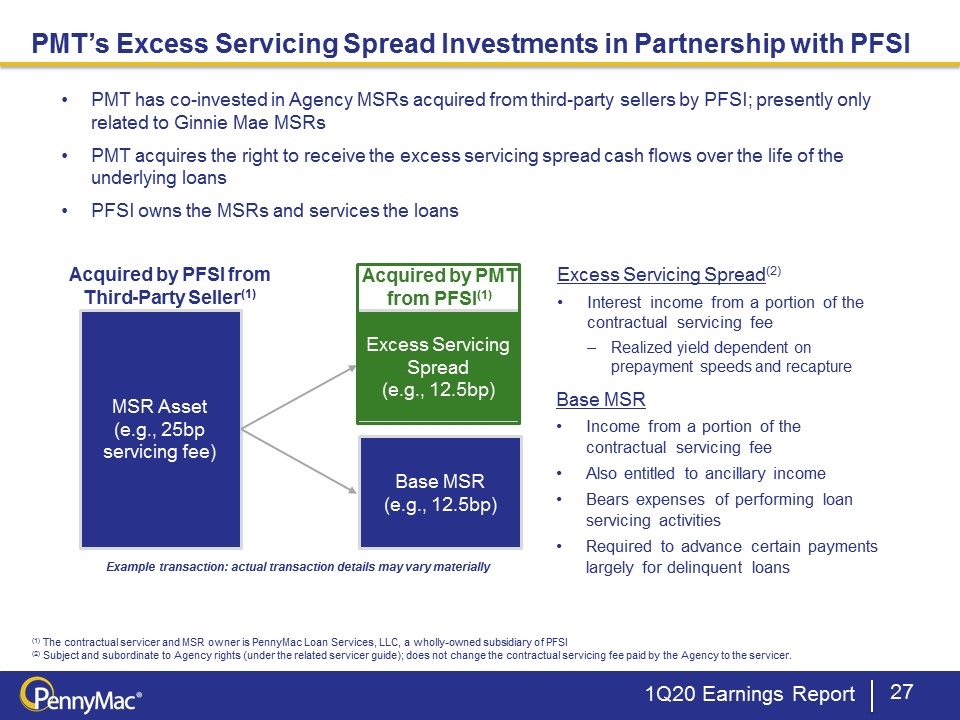
(1) The contractual servicer and MSR owner is PennyMac Loan Services, LLC, a wholly-owned subsidiary of PFSI (2) Subject and subordinate to Agency rights (under the related servicer guide); does not change the contractual servicing fee paid by the Agency to the servicer. Excess Servicing Spread (e.g., 12.5bp) MSR Asset (e.g., 25bp servicing fee) Acquired by PFSI from Third-Party Seller(1) PMT has co-invested in Agency MSRs acquired from third-party sellers by PFSI; presently only related to Ginnie Mae MSRs PMT acquires the right to receive the excess servicing spread cash flows over the life of the underlying loans PFSI owns the MSRs and services the loans Excess Servicing Spread(2) Interest income from a portion of the contractual servicing fee Realized yield dependent on prepayment speeds and recapture Base MSR Income from a portion of the contractual servicing fee Also entitled to ancillary income Bears expenses of performing loan servicing activities Required to advance certain payments largely for delinquent loans Base MSR (e.g., 12.5bp) Acquired by PMT from PFSI(1) Example transaction: actual transaction details may vary materially PMT’s Excess Servicing Spread Investments in Partnership with PFSI 1Q20 Earnings Report
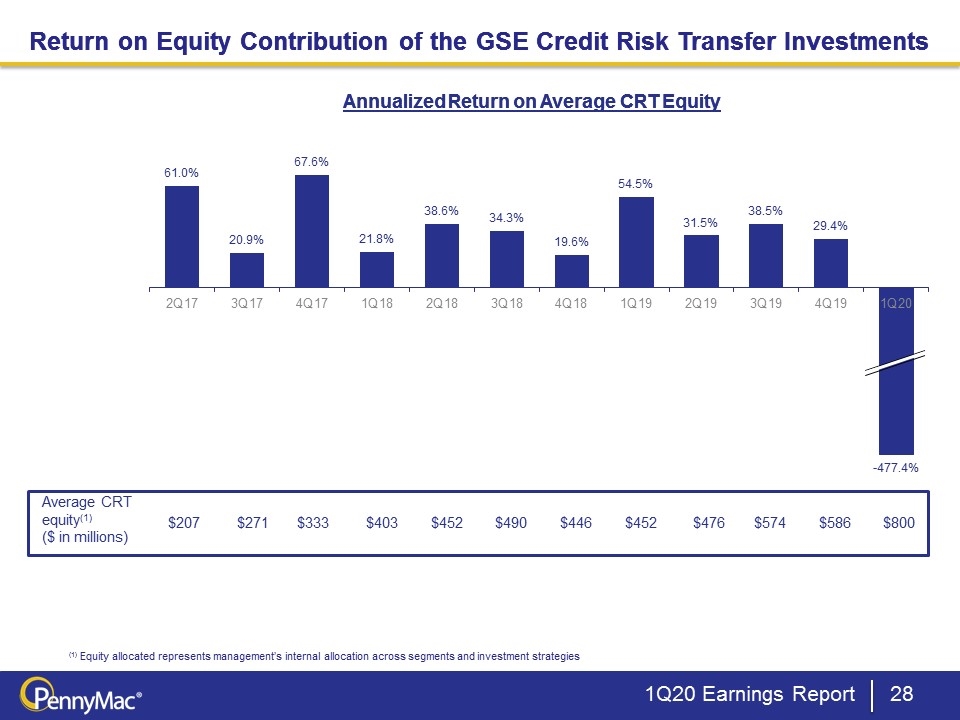
Return on Equity Contribution of the GSE Credit Risk Transfer Investments 1Q20 Earnings Report Annualized Return on Average CRT Equity (1) Equity allocated represents management’s internal allocation across segments and investment strategies Return on Equity Contribution of the GSE Credit Risk Transfer Investments Annualized Return on Average CRT Equity Average CRT equity(1) ($ in millions) $207 $271 $333 $403 $452 $490 $446 $452 $476 $574 $586 $800
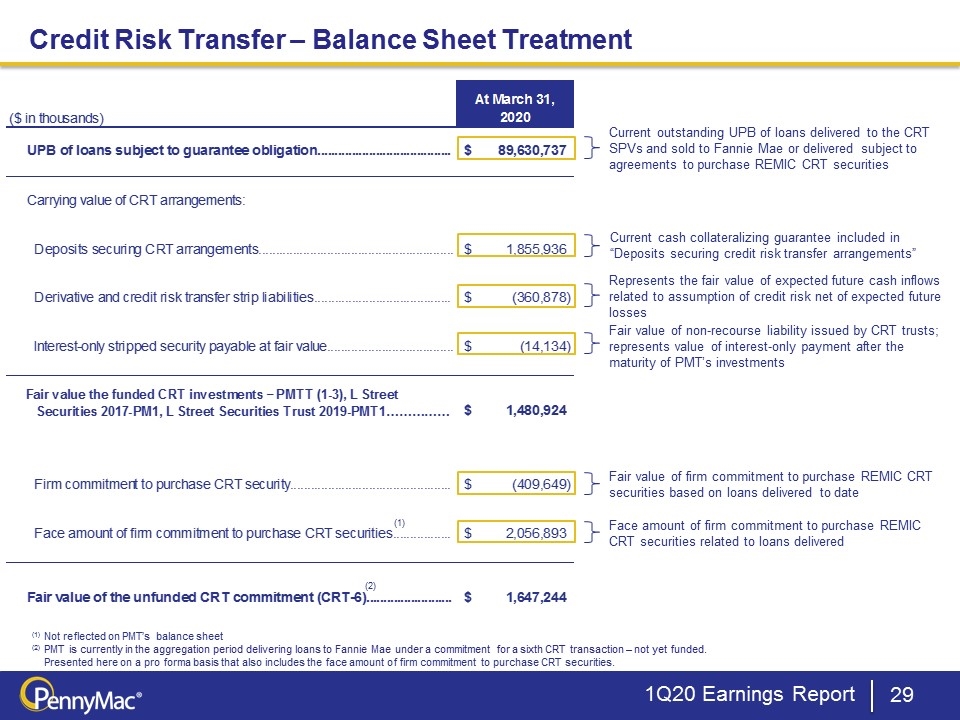
Current outstanding UPB of loans delivered to the CRT SPVs and sold to Fannie Mae or delivered subject to agreements to purchase REMIC CRT securities Credit Risk Transfer – Balance Sheet Treatment Current cash collateralizing guarantee included in “Deposits securing credit risk transfer arrangements” Represents the fair value of expected future cash inflows related to assumption of credit risk net of expected future losses Fair value of firm commitment to purchase REMIC CRT securities based on loans delivered to date Face amount of firm commitment to purchase REMIC CRT securities related to loans delivered 1Q20 Earnings Report Fair value of non-recourse liability issued by CRT trusts; represents value of interest-only payment after the maturity of PMT’s investments (1) (1) Not reflected on PMT’s balance sheet (2) PMT is currently in the aggregation period delivering loans to Fannie Mae under a commitment for a sixth CRT transaction – not yet funded. Presented here on a pro forma basis that also includes the face amount of firm commitment to purchase CRT securities. (2)
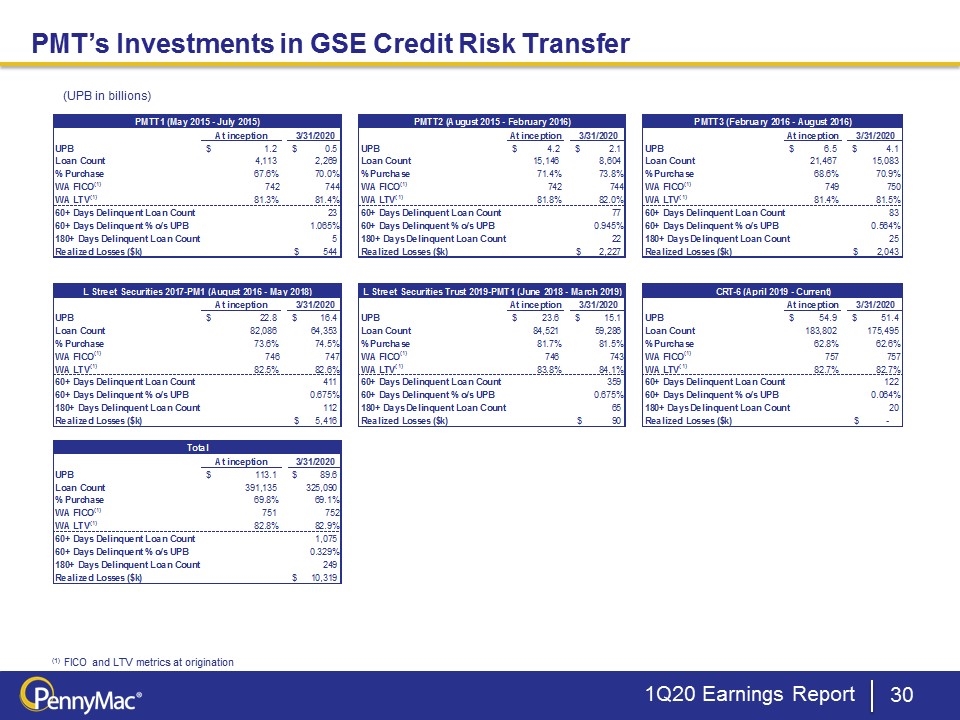
PMT’s Investments in GSE Credit Risk Transfer 1Q20 Earnings Report (1) FICO and LTV metrics at origination (UPB in billions)
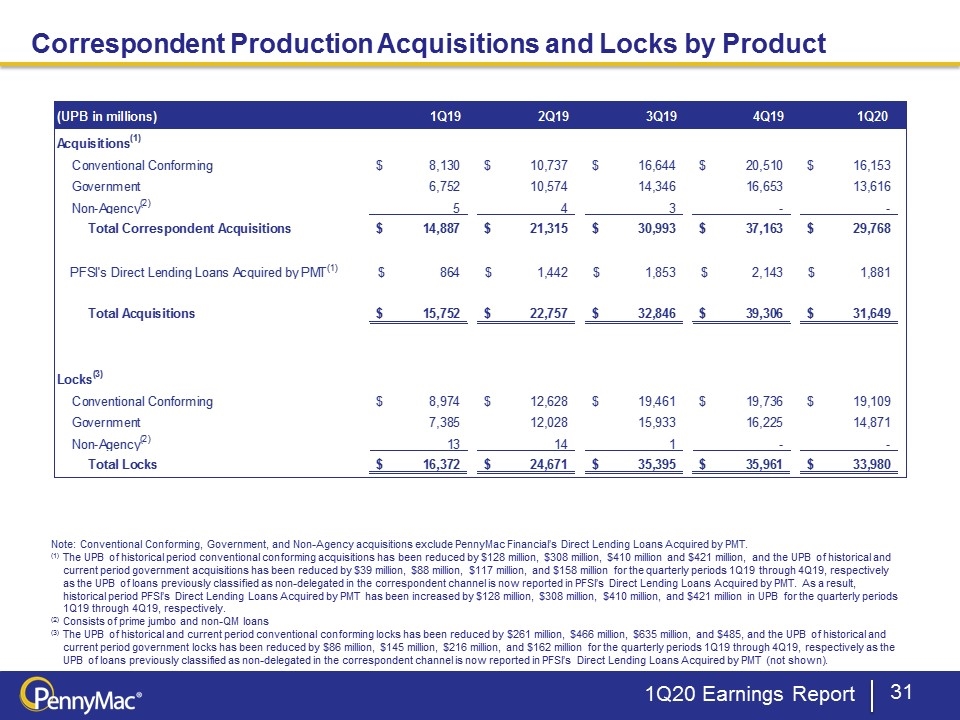
Correspondent Production Acquisitions and Locks by Product 1Q20 Earnings Report Note: Conventional Conforming, Government, and Non-Agency acquisitions exclude PennyMac Financial’s Direct Lending Loans Acquired by PMT. (1) The UPB of historical period conventional conforming acquisitions has been reduced by $128 million, $308 million, $410 million and $421 million, and the UPB of historical and current period government acquisitions has been reduced by $39 million, $88 million, $117 million, and $158 million for the quarterly periods 1Q19 through 4Q19, respectively as the UPB of loans previously classified as non-delegated in the correspondent channel is now reported in PFSI’s Direct Lending Loans Acquired by PMT. As a result, historical period PFSI’s Direct Lending Loans Acquired by PMT has been increased by $128 million, $308 million, $410 million, and $421 million in UPB for the quarterly periods 1Q19 through 4Q19, respectively. (2) Consists of prime jumbo and non-QM loans (3) The UPB of historical and current period conventional conforming locks has been reduced by $261 million, $466 million, $635 million, and $485, and the UPB of historical and current period government locks has been reduced by $86 million, $145 million, $216 million, and $162 million for the quarterly periods 1Q19 through 4Q19, respectively as the UPB of loans previously classified as non-delegated in the correspondent channel is now reported in PFSI’s Direct Lending Loans Acquired by PMT (not shown).






























